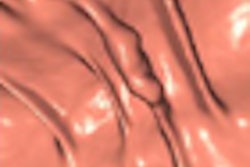Use of an automated postprocessing tool eliminates the need for both a stress and rest exam in myocardial perfusion MRI, according to researchers from Germany. They found that quantitative assessment of stress MRI images alone delivers the same diagnostic performance as semiquantitative evaluation of both stress and rest perfusion exams.
"MR perfusion imaging is a rapidly evolving method that provides high temporal resolution without radiation exposure; therefore, it's a good alternative to SPECT," said Dr. Armin Huber from the Technical University of Munich in Germany.
But while semiquantitative evaluation methods for myocardial perfusion imaging "are already well established and investigated in the literature," he said, few researchers have tried to evaluate quantitative evaluation methods.
"We wanted to compare two postprocessing methods for MR perfusion: first, a semiquantitative evaluation that requires a stress and rest exam, and second, a quantitative evaluation that needs only a stress exam," Huber said at the 2009 European Congress of Radiology (ECR) in Vienna.
The reference methods included invasive coronary angiography and stress wire examinations.
"The question was whether we could do a stress exam alone and achieve comparable diagnostic accuracy as with the stress and rest evaluation, and, is it better if we use quantitative instead of semiquantitative evaluation," Huber said.
The study included 31 patients with suspected coronary artery disease who underwent 1.5-tesla MRI and coronary angiography. Stenoses were classified as normal if they were < 50% of the lumen diameter. Stenoses between 50% and 75% were evaluated by an intracoronary pressure wire examination to assess their relevance.
Signal-intensity time curves of first-pass MR perfusion images (SR-turboFLASH, stress/rest) were analyzed by digital subtraction angiography using syngo Argus software (Siemens Healthcare, Erlangen, Germany).
For the semiquantitative evaluation, the upslope (US) value of a linear fit from the foot point to the signal maximum was calculated for each of the 18 heart segments. For the quantitative evaluation, a model-independent deconvolution method was used to calculate myocardial blood flow (MBF).
The researchers measured US and MBF for each segment in the stress and rest exams, and determined the ratio of the stress and rest value for each segment (MPRI). Coronary artery stenosis > 75% or > 50% with positive fractional flow reserve < 0.75 were considered as hemodynamically relevant. Receiver operator characteristics (ROC) curves were calculated.
According to the results, the values of the area under the ROC curves were 0.78, 0.56, and 0.92 for the USStress, USRest, and USMPRI evaluation (semiquantitative evaluation), respectively. The values for the MBFStress, MBFRest, and MBFMPRI (quantitative evaluation) were 0.92, 0.68, and 0.84, respectively.
Comparing the best values of the semiquantitative measurements USMPRI (0.92) and MBFStress (0.92), the researchers found no significant differences (p < 0.001).
"Therefore we only need the stress exam," he said. "We conclude that the myocardial blood flow from stress exam at first-pass plus MR perfusion images is the best quantitative parameter. It achieves comparable diagnostic accuracy to the myocardial perfusion research index [USMPRI] of the semiquantitative evaluation."
"Maybe the semiquantitative evaluation ought to be used only for stress, not stress and rest, though the results need to be confirmed in a larger patient population," Huber said.
For clinical implementation to occur on a larger scale, the deconvolution software developed at the university would need to be available commercially, Huber said.
By Eric Barnes
AuntMinnie.com staff writer
June 12, 2009
Related Reading
Gated SPECT best indicator for cardiac events, April 13, 2009
ACC study: Most cardiac SPECT scans are appropriate, April 1, 2009
3D CT detection of perfusion defects mirrors SPECT, March 8, 2009
MRI, MDCT err in estimating cardiac functional parameters, February 20, 2009
MRI evaluation of chest pain cuts acute coronary syndrome, August 15, 2008
Copyright © 2009 AuntMinnie.com


















